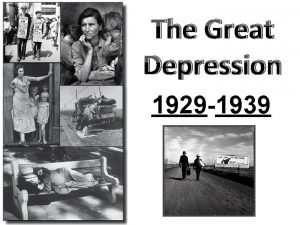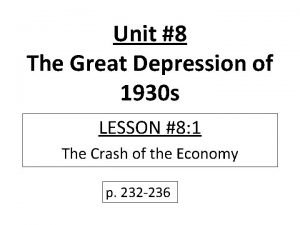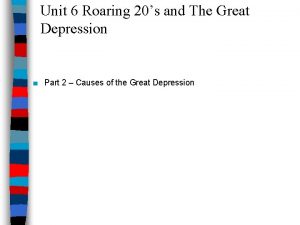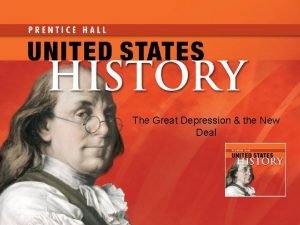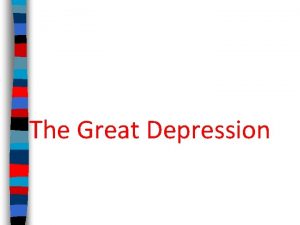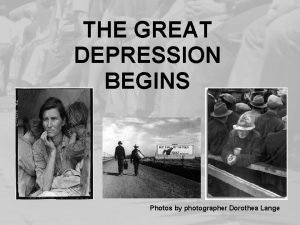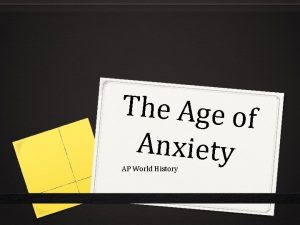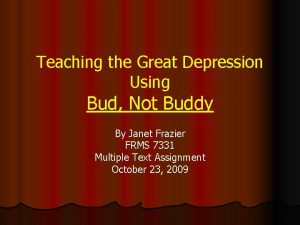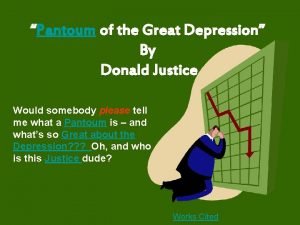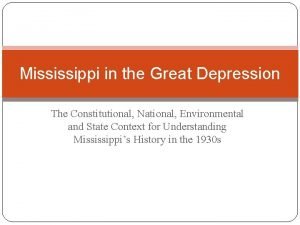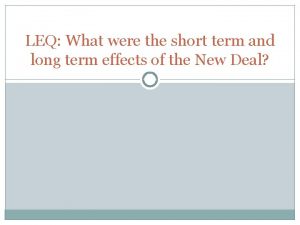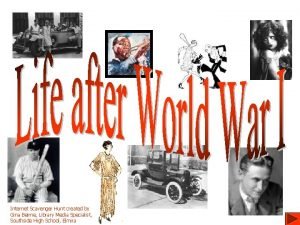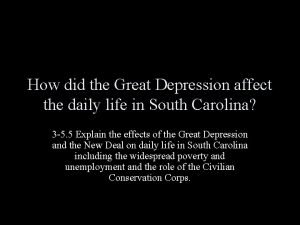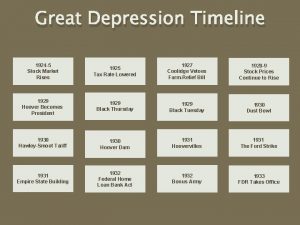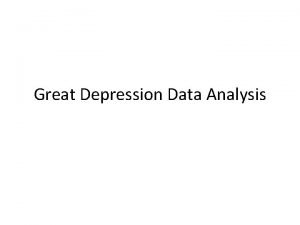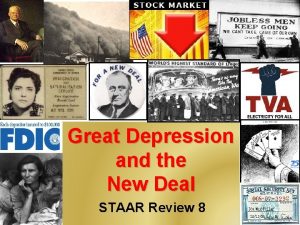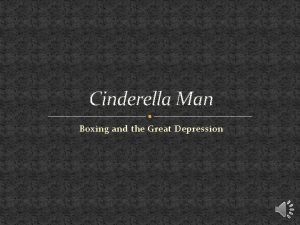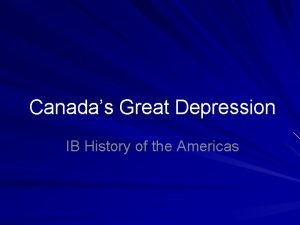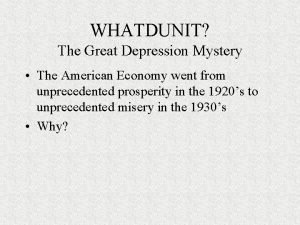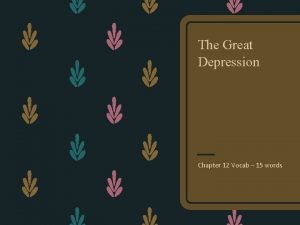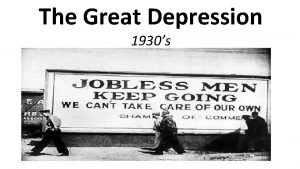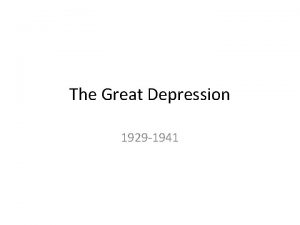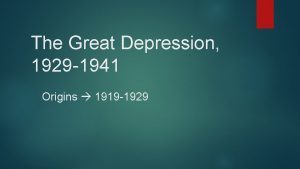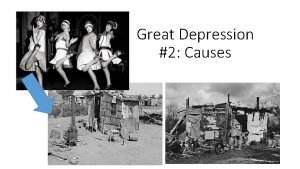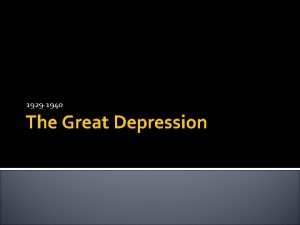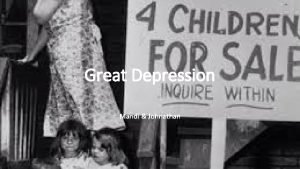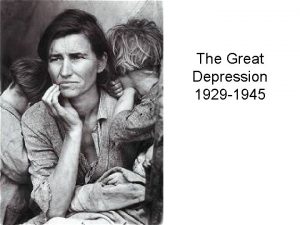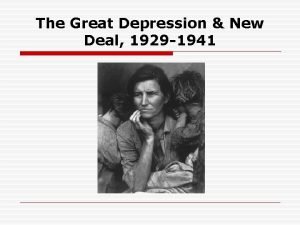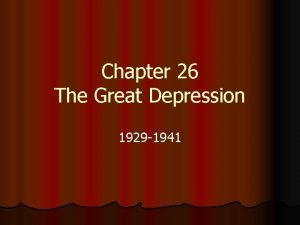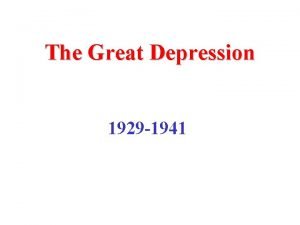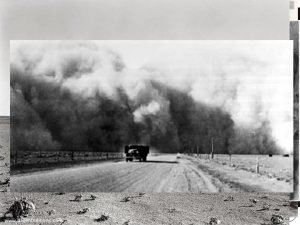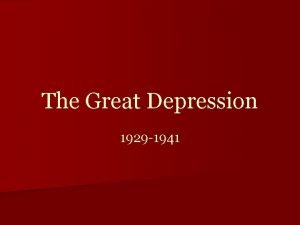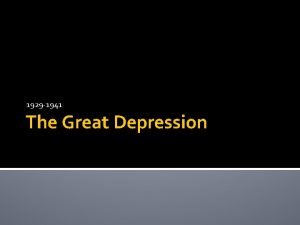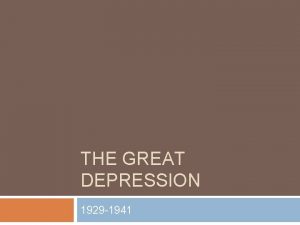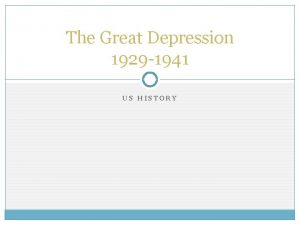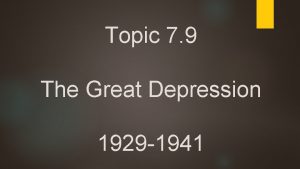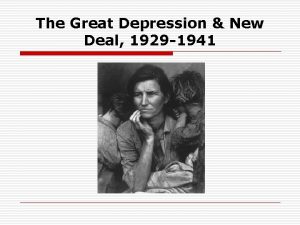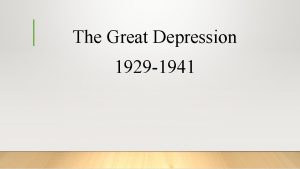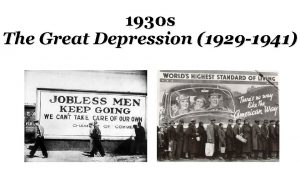Great Depression 1929 1941 What is the difference




























- Slides: 28

Great Depression 1929 -1941

What is the difference between a Recession (What we’re in now) and a Depression?

Causes of the Great Depression • Great Crash • The roaring 20 s ended in 1929 when the U. S. stock market crashed (Great Crash) • Depression in agricultural selling • Unemployment • Surplus in goods http: //www. youtube. com/watch? v=Q 9 fh 4 a. Tc OLg

Weak Banking structure • No regulation of stock market • Tax policies favored the rich • Monopolies were not challenged by the Sherman antitrust laws • Banks were not federally owned and operated

Critics of the Trickle Down Theory

Unequal Distribution of Wealth • 1920 s— 40%of all families had an income less than $1500 • 1% of the population owned 59% of the nations wealth • 87% owned 10% of the wealth – Economy was dependent on a small portion of consumers http: //www. youtube. com/watch? v=o. Owj. N 9 q. V 2 ls

President Herbert Hoover 1929 -1933

Hoover’s Plan • By 1929 25% of workers were • • • unemployed “Prosperity is just around the corner” “Just work harder” Trickle Down Theory – Give money to big business/the rich and eventually it will trickle down to the poor (Reconstruction Finance Corporation) Federal Works Businesses said they wouldn’t lower wages

Failure of Hoovers Plan • In 1932 thousands of WWI • • • vets marched on Washington D. C. to demand their bonuses (Bonus Army) He used the current Army to disperse the Bonus Army Economy would eventually work itself out He believed that government shouldn’t solve societies problems Homeless slept in “HOOVERVILLES” under “HOOVER BLANKETS” He believed that if he helped it would hurt peoples self esteem (RUGGED INDIVIDUALISM)



Human Impact of the Great Depression • By 1932 25% of workers were unemployed • “Bread Lines, Soup Kitchens” • African Americans and unskilled workers were the first to experience the depression (30%-60% unemployment)


Culture of the Great Depression Not necessary to write this down • Pop culture was designed to • • make people forget about their problems Baseball took a major hit People played miniature golf, softball, pinball and Monopoly Dick Tracy Movies included King Kong, Gone with the Wind and the Wizard of Oz

FDR The New Deal

1. How would FDR get his message across to the American public? http: //www. youtube. com/watch? v=z 9 CBpbu. V 3 ok

Now that you’ve heard an example of a Fireside Chat, tell me why if you were an American living during this time period, would you put your faith in this man? How was he different than President Hoover?

The 3 R’s of the New Deal • Relief – Relieve those who are suffering (immediate) • Recovery – Recovery for the economy make it grow again (long term) • Reform – Avoid future depressions (permanent)

Relief Legislation • Emergency Banking Act of 1933 – First at was to declare a banking holiday where he shut down the banks until they were federalized • Federal Emergency Relief Act of 1933 – Between 1933 and 1935 $500, 000 was given to direct aid to states in order to aid those who were suffering • Public Works Administration of 1933 – PWA provided works for construction projects such as bridges, houses, hospitals and schools

Relief Continued • Civilian Conservation Corps of 1933 • Employed young in reforestation, road construction, and flood control projects • Works Progress Administration of 1935 – Similar to the Public Works Administration except that only women could join • Tennesee Valley Authority of 1933 – Creates independent public corporation to construct dams and power projects

Recovery Legislation • National Industrial Recovery Act of 1933 – Fair competition, minimum wages, maximum hours • Home Owners Loan Corporation – Designed to keep people from losing their homes • Agricultural Administration Adjustment Act – Cut the amount of crops and livestock (1 st) – Gov’t paid farmers to store portions

Reform Legislation • FDIC • • – Guaranteed bank deposits of up to $5, 000 Securities Exchange Act of 1934 – Regulate stocks Social Security Act of 1935 – Old age insurance – Unemployment – Handicap insurance National Labor Relations of 1935 – Right to unionize and collective bargaining Fair Labor Standards Act of 1938 – Minimum wage of $. 25 and maximum work week of 44 hours

Rural Life • Dust Bowl – Drought occurred in Texas, Oklahoma, Kansas, Colorado and New Mexico – “Okies”—workers who moved to California to find work

Supreme Court Cases of the New Deal • Schechter Poultry Corporation vs. The U. S. – Court ruled that the law illegally gave Congress power to regulate commerce • U. S. vs. Butler – Court rules that the AAA was unconstitutional due to the fact that agriculture was a local, not a state matter



Court Packing Plan • FDR wanted to increase the number of judges from 9 to 15 • He also wanted to mandate that Justices retire when they reach the age of 70 • Plan was shot down because of the separation of powers

Evaluating the New Deal • WWII was largely responsible for the end of the • • • Depression didn’t solve unemployment New Deal helped people cope with their issues New Deal brought more power to the President Did preserve the basis of our economy People thought it didn’t go far enough – Huey Long/Father John Coughlin wanted Socialism • Rich thought they were being punished
 Great depression
Great depression Stock market crash 1929 political cartoons
Stock market crash 1929 political cartoons Stock market crash 1942
Stock market crash 1942 Vocabulary review causes of the depression
Vocabulary review causes of the depression Rarig great depression
Rarig great depression Great depression
Great depression The ingenious quarterback political cartoon
The ingenious quarterback political cartoon Foreclosure great depression
Foreclosure great depression Five effects of the great depression
Five effects of the great depression Five effects of the great depression
Five effects of the great depression How did the great depression impact the world
How did the great depression impact the world Great depression ap world history definition
Great depression ap world history definition Bud not buddy great depression
Bud not buddy great depression Pantoum of the great depression
Pantoum of the great depression The great depression summary
The great depression summary What is deflation
What is deflation Okies great depression
Okies great depression The great depression leq
The great depression leq Five effects of the great depression
Five effects of the great depression How did the great depression affect daily life
How did the great depression affect daily life Timeline of the great depression
Timeline of the great depression Great depression causes
Great depression causes Mexican repatriation apush
Mexican repatriation apush Hoovervilles
Hoovervilles Birth rate during the great depression
Birth rate during the great depression Overspeculation great depression
Overspeculation great depression Great depression vocab
Great depression vocab Great depression vocabulary
Great depression vocabulary Poverty during the great depression
Poverty during the great depression
